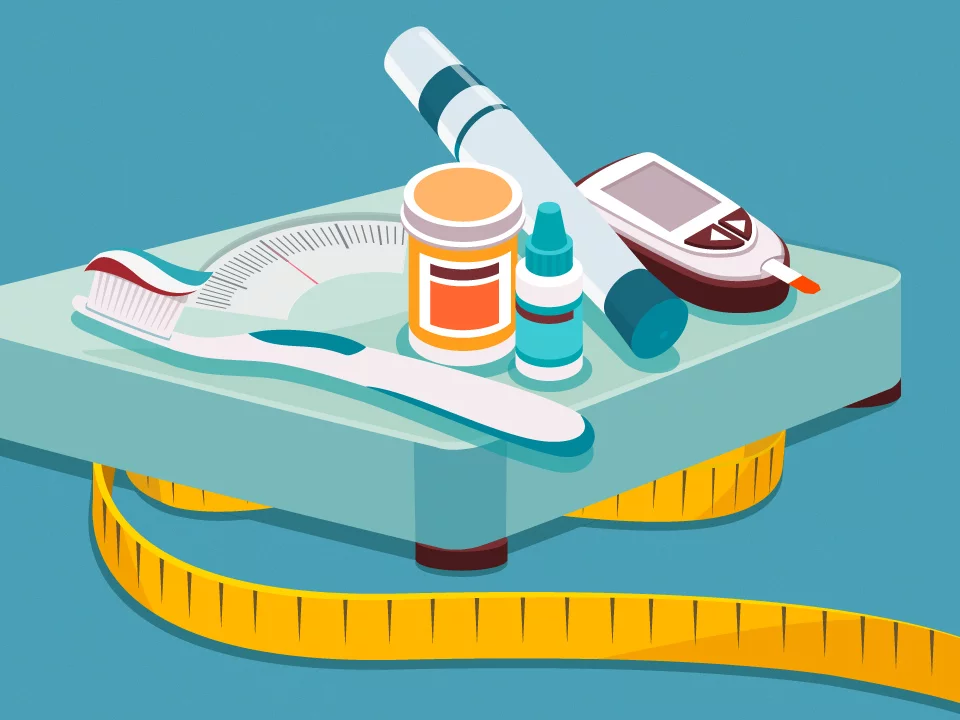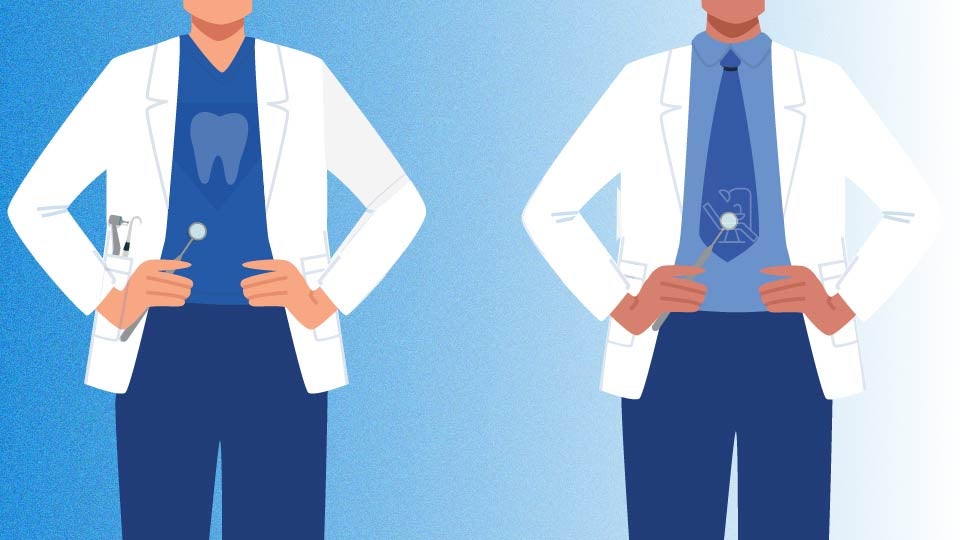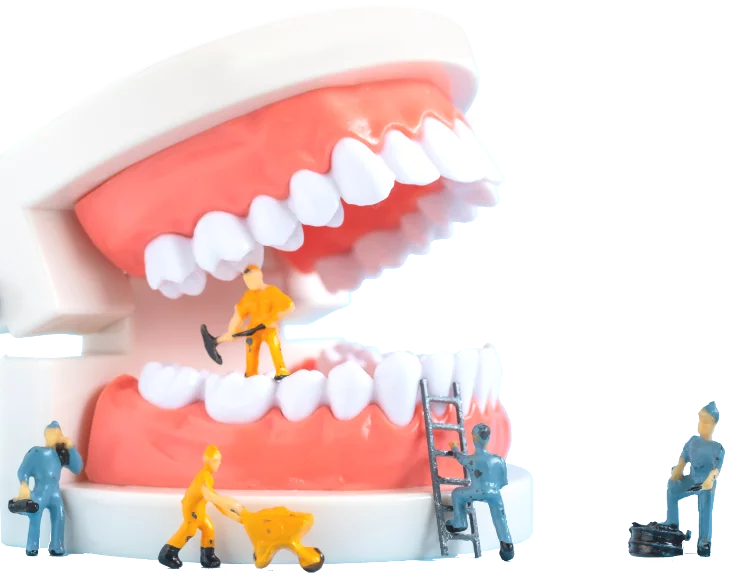Blog Summary GLP-1s for diabetes can shrink your waistline and your saliva; here’s why that matters for your teeth as dentists are seeing what's been dubbed “Ozempic teeth”. This is a guide to what patients should know if they're taking GLP-1 agonists and how to prevent damage with hydration habits, saliva screenings, and targeted periodontal therapy.
They’re medications that have taken the world of weight loss by storm, with names like Ozempic, Wegovy and Rybelsus. Much of the popularity of these semaglutides today stems from word-of-mouth and celebrities crediting their smaller waistlines to the medications. Two of these GLP-1 agonists – Ozempic and Rybelsus – were approved by the Food and Drug Administration specifically to treat type 2 diabetes, while Wegovy was approved for weight loss. However, studies show that weight loss is an effect of all three medications. With the rise of these medications also come reports of side effects, including what’s been dubbed “Ozempic teeth.”
If you have diabetes or are prediabetic and are taking semaglutides or considering them, here’s what you need to know about maintaining the health of your mouth and managing diabetes.
How GLP-1 Medications Help People with Type 2 Diabetes
They lower blood sugar by helping your body release insulin when you eat, reducing glucagon – a hormone that your pancreas makes that helps regulate your blood sugar, slowing stomach emptying, and curbing appetite—a powerful combo for the ability for your body to process and use energy efficiently. [1]
Does GLP-1 Dosage Matter?
Yes. Gastrointestinal side effects are more common during dose increases and at higher doses, including nausea, vomiting, diarrhea, and constipation. Long-term, repeated acid and dryness in the mouth can thin the tooth enamel, leading to sensitivity, cavities, cracks, and yellowing, and chronically irritated gums can progress to gum disease, bone loss, and even loose or lost teeth. Inflammation in the mouth can make blood sugar harder to control. A gradual increase in medication dosage aims to reduce this. [2][3]
How GLP-1 Can Affect the Mouth
When a patient’s appetite is suppressed and gastrointestinal symptoms occur, this means a patient is taking in less fluids, is more dehydrated and has lower saliva flow. Sometimes, a patient may experience delayed gastric emptying – when the stomach takes longer to empty – which leads to acid reflux or vomiting. The acid softens enamel, accelerates erosion, and intensifies gum disease. [4]
Correlation Between Gum Disease and Diabetes
What to Tell Your Dentist if You Are on GLP-1
Tell your dentist about any daily symptoms of dry mouth, reflux, or vomiting, nutrition/hydration habits, and your latest A1c. Include the specific drug/brand, the current dose and gradual dosage increase, and the start date.
What can you do to improve maintain your oral health and prevent gum disease while taking semaglutides?
Rinse with water: After any reflux or vomiting, swish with water (or a small pinch of baking soda in water). Wait about 30 minutes before brushing so you don’t scrub softened enamel.
Keep saliva flowing: Sip water often; chew sugar-free (xylitol) gum; avoid constant sipping of acidic drinks (soda, energy drinks, citrus waters).
Take an in-office saliva screening (OralFitnessCheck®, aMMP-8): This detects active inflammation and breakdown of gums surrounding your teeth—no needles. [7][8]
If high risk, take the MyPerioPath® saliva test: This measures which harmful bacteria are present so your care can be personalized. [9]
Treat what’s discovered: Your dentist can go below the gums to target infection and inflammation with deep cleaning, laser treatments, and irrigation — the use of pressurized water to reduce bacteria. [10][11]
Re-screen: Repeat the saliva screening in 8–12 weeks, compare results and update your doctor. Track your progress. Data beats guessing.
You can get whole-body insights during a routine checkup in our offices. Remember to hydrate, screen early, treat proactively, track progress—and protect your smile while you manage your blood sugar levels.
Dr. Christopher Tolmie is a multi-practice owner in South Florida, focusing on comprehensive oral health through his Mouth-Body Connection® philosophy. He holds dual doctorates in dental surgery (University of Maryland) School of Dental Surgery and osteopathic medicine (Philadelphia College of Osteopathic Medicine), along with an MBA from the University of Miami.
Find your trusted, local dentist today!
Sources
[2] FDA. Ozempic® (semaglutide) Prescribing Information (2025). accessdata.fda.gov/drugsatfda_docs/label/2025/209637s025lbl.pdf. FDA Access Data
[4] Columbia Univ. “Brushing immediately after meals? You may want to wait.” (2022). cuimc.columbia.edu/go/teeth-wait. cuimc.columbia.edu
[5] Simpson TC, et al. Cochrane Review (2022 update) — Periodontal therapy and HbA1c. doi.org/10.1002/14651858.CD004714.pub4. Cochrane Library+1
[6] Engebretson SP, et al. JAMA. 2013 — RCT: periodontal therapy did not change HbA1c at 6 mo. doi.org/10.1001/jama.2013.282431. JAMA Network
[7] Wei S, et al. J Clin Periodontol. 2024 — aMMP-8 POCT accuracy (systematic review). doi.org/10.1111/jcpe.14000. Wiley Online Library
[11] Arnett MC, et al. J Periodontol. 2023 — SRP ± minocycline microspheres; clinical & microbial outcomes. doi.org/10.1002/JPER.23-0002. aap.onlinelibrary.wiley.com
Smile Generation blog articles are reviewed by a licensed dental professional before publishing. However, we present this information for educational purposes only with the intent to promote readers’ understanding of oral health and oral healthcare treatment options and technology. We do not intend for our blog content to substitute for professional dental care and clinical advice, diagnosis, or treatment planning provided by a licensed dental professional. Smile Generation always recommends seeking the advice of a dentist, physician, or other licensed healthcare professional for a dental or medical condition or treatment.







